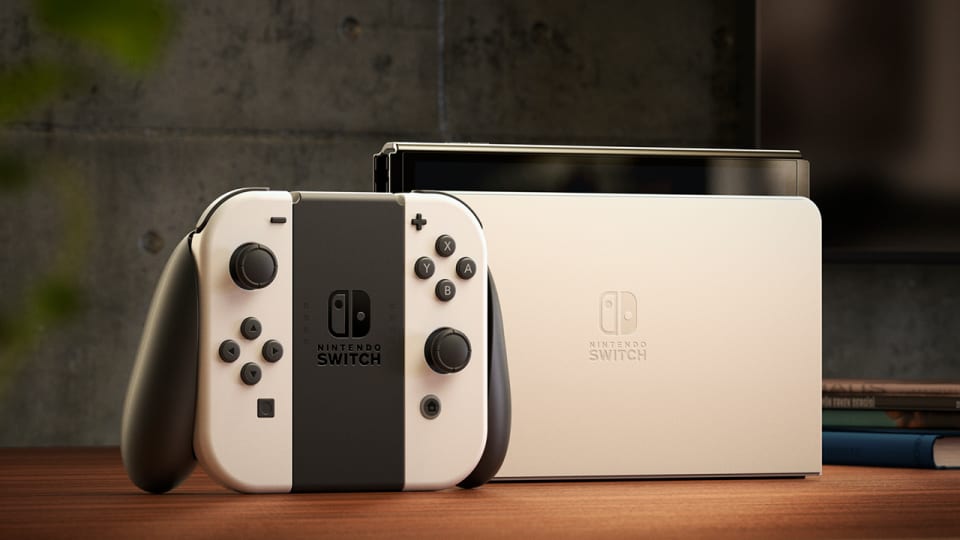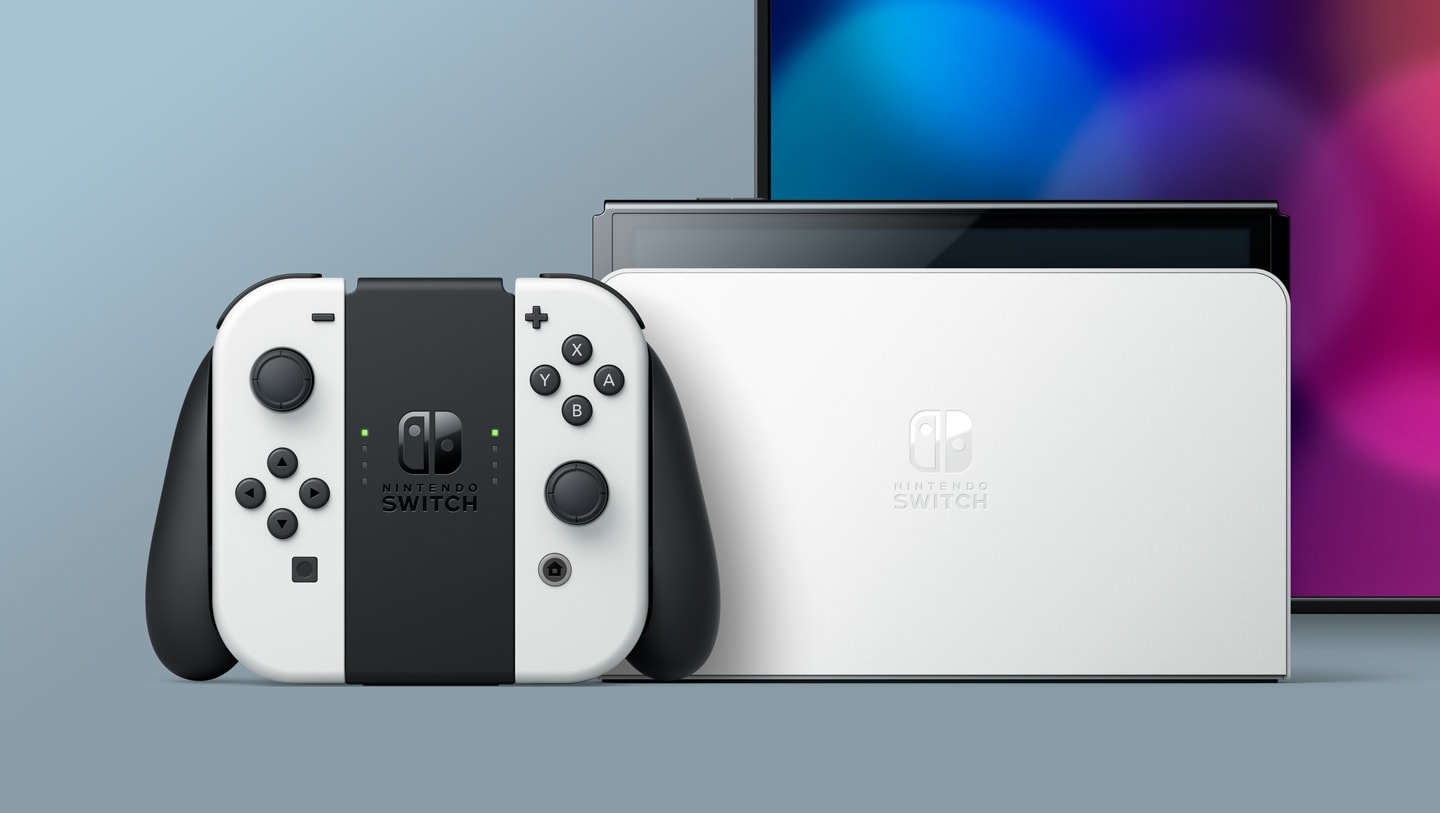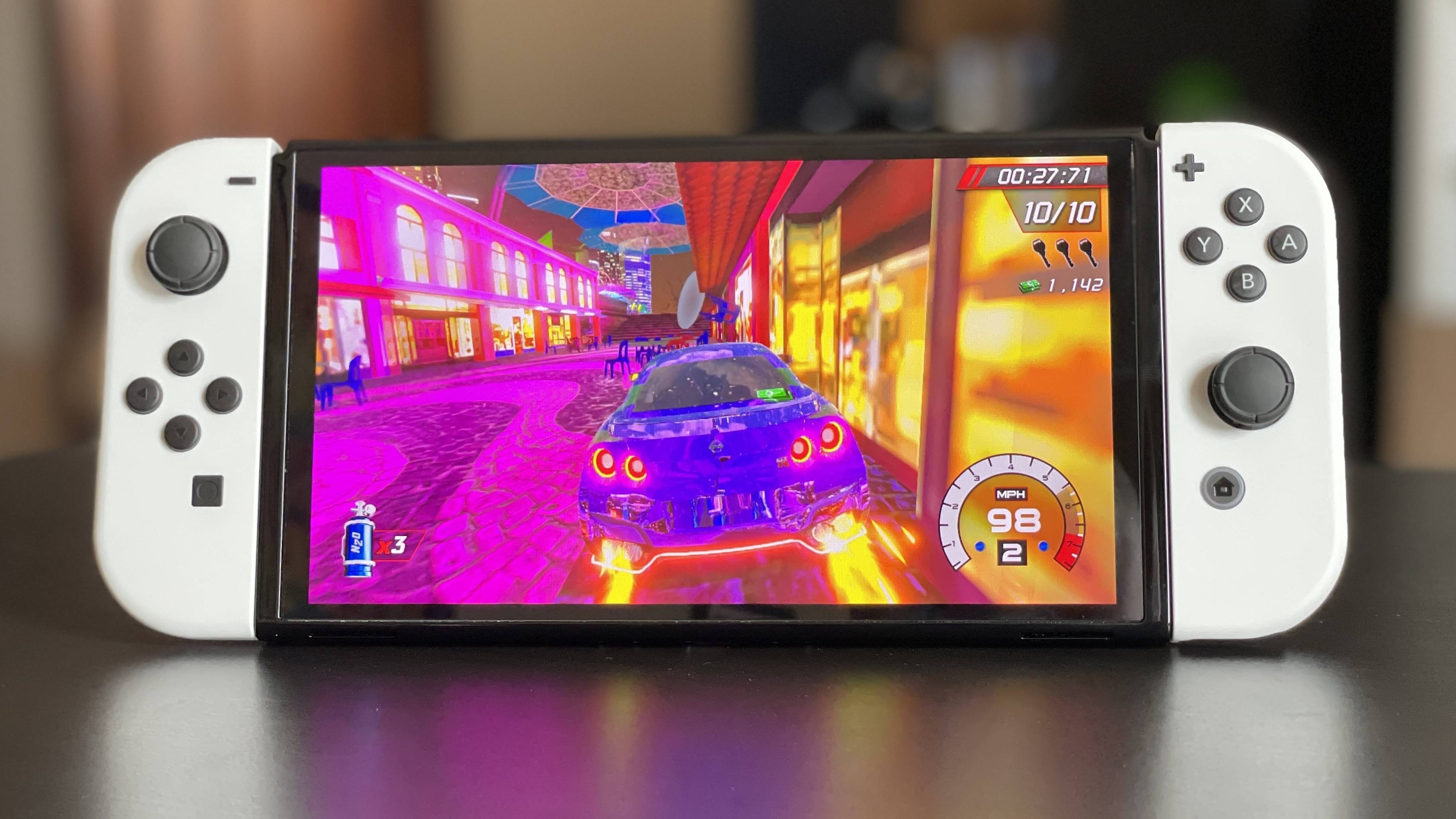
As soon as you turn on the Nintendo Switch OLED, you’ll be impressed. With its super-slim bezels, excellent blacks, and vibrant colors, the new 7-inch display captivates you to the point where you’ll wonder how you ever got by with the original Switch’s mediocre LCD panel. Here is the Nintendo Switch OLED review you’ve been waiting for.
The appealing OLED display isn’t the only thing that makes this love at first sight. The improved speakers, which are now neatly disguised behind the main attraction of the console, are notably impressive. When playing our favorite games, the Switch’s characteristic ‘click’ has never sounded so crisp and clear, and we didn’t feel the need to go for a set of headphones.
On one hand, it’s easy to fall in love with the Switch OLED because it does everything it sets out to do so perfectly. On the other hand, it’s easy to be disappointed with the Switch OLED because it’s such a minor increase at a time when the Switch could really benefit from a full 4K model.
The Switch OLED is essentially identical to the base model, with the exception of a nicer screen and a few cosmetic tweaks. And, while the screen is lovely, it doesn’t change the experience of using the Switch in handheld mode significantly. When you play your Switch in docked mode, the OLED on the Switch doesn’t change anything.
Table of Contents
Let’s dive into the Nintendo Switch OLED Review-
Price and Availability
The Nintendo Switch OLED is the fourth edition of Nintendo’s home system, and it was released on October 8, 2021. It costs $349.99 / £309.99 / AU$539.95, which is somewhat more than the original Nintendo Switch, which costs $299.99 / £259.99 / AU$469.95, and clearly more than the Nintendo Switch Lite, which costs $199.99 / £199.99 / AU$329.95.

However, the extra cost of the Nintendo Switch OLED model appears justified. The console has been modified to contain a 7-inch OLED display, improved speakers, double the internal storage, and a wider kickstand, as well as a somewhat improved dock with a LAN port for more stable online play.
Design
You wouldn’t notice any design variations between the Switch OLED and the original Switch if it weren’t for the larger screen and new pure white Joy-Con controllers. However, if you look closely, you’ll notice significant differences. The Switch OLED, on the other hand, has a touch more heft to it. With the Joy-Con attached, it weighs 422 grams, which is 22 grams more than the Nintendo Switch.

The most noticeable new design feature is the new 7-inch OLED display, which is quite dramatic despite being only 0.8 inches larger than the original Switch’s 6.2-inch screen. As a result, the Switch OLED is slightly larger than its predecessor: at 9.5 x 0.55 x 4 inches (W x D x H), it’s 0.1 inch longer than its predecessor, yet it still feels instantly comfortable in the hands.
The rear of the console is constructed of black matte plastic, and the kickstand is imprinted with a grey Nintendo Switch logo. And this kickstand, oh, this kickstand! Instead of that little stubby thing I was always afraid would break off (it never did, but it’s still a worry in the back of my mind), Nintendo gave gamers something far more solid.
The kickstand extends almost the whole length of the console and flips halfway up, allowing for a very comfortable viewing angle. The hinges are a little stiff for my liking, but it’s a good addition to the system overall. When you slightly raise the kickstand, you’ll notice the microSD slot peeking out, ready for you to upgrade the capacity from 64GB.
Also Checkout: Best Gaming Monitors In 2021 To Boost Your Gaming Setup (Top 10)
Display
From a hardware sense, the Switch OLED differs from the base model in two major ways and one minor but significant way. The 7-inch OLED panel, as opposed to the 6-inch LCD screen on the basic Switch, is the most visible difference.

The Switch OLED’s centrepiece is the OLED screen, which has received the majority of Nintendo’s plaudits. Crisp images with brilliant colours and deep blacks are rendered on the bigger screen. When you play a game with dark, complex levels, like Metroid Dread’s alien dungeons or The Legend of Zelda: Breath of the Wild’s frightening castles, the experience feels even more immersive than before. While the visual quality of a 7-inch OLED and a 6-inch LCD isn’t drastically different, the colour richness is.
Kickstand and Speakers
Other improvements to the Switch OLED are more minor, but nonetheless useful. Instead of being a basic, flimsy piece of plastic, the kickstand now runs the length of the smartphone. This allows you to prop up the Switch OLED on a variety of surfaces without worrying about it falling over. Furthermore, the Switch OLED’s dock has an Ethernet connector, eliminating the need for a second adapter.
/cdn.vox-cdn.com/uploads/chorus_asset/file/22701274/newswitch_kickstand.jpg)
Then there are the speakers, which don’t appear to have changed much yet sound far better. The speakers on the Switch OLED are slightly larger and have a more rectangular appearance. However, the most significant change is that they sound far better than before, with a crisper, more complex soundscape even at lower volumes.
Also Checkout: 8 Best Photo Editing Apps for iPhone
Performance
Despite the fact that the original Nintendo Switch is reaching its fifth birthday, the Nintendo Switch OLED model provides no performance gain. Aside from the improved display, the top Switch games look and perform the same as they did before, thanks to the new console’s Nvidia Custom Tegra X1 processor and 4GB of RAM, which may disappoint those who were hoping for a more powerful Switch model.

Of course, most Switch titles are still playable, but the console’s hardware is beginning to show its age, especially now that the PS5 and Xbox Series X are on the market. In handheld mode, you can anticipate 720p at 60 frames per second, and in docked mode, 1080p at 60 frames per second.
TV Mode and Tabletop Mode
In TV mode, the Nintendo Switch OLED, unfortunately, offers no upgrades over its predecessor. Yes, the new dock has a LAN port for more stable online gaming than Wi-Fi, but the 720p UI and a maximum output resolution of 1080p remain the same.
With 4K TVs becoming more ubiquitous in most homes, the Switch OLED’s lack of 4K capability appears to be a major error. Even the Xbox One S, which came out in 2016, is capable of 4K output. The Nintendo Switch OLED also lacks capability for high dynamic range, or HDR, as it’s frequently referred to.

The Nintendo Switch OLED’s performance in tabletop mode is another advantage. It’s now much easier (and safer) to use the Switch in tabletop mode, which is ideal for spontaneous multiplayer sessions, thanks to its broader, redesigned kickstand. The hinge is significantly more durable, and when closed, it emits a gratifying thud – unlike the old kickstand, we don’t have any fears about it loosening over time and failing to snap into place.
Whereas the traditional kickstand only allowed for one viewing angle, the Switch OLED’s movable stand allows for several positions. It provides for a far more enjoyable viewing experience, and the OLED display’s superior viewing angles mean you won’t have to huddle together as tightly in Mario Kart 8 Deluxe.
Also Checkout: 10 Best Keyboards that you can buy in 2021
Game Library
Of course, buying a Nintendo Switch OLED is mostly motivated by a desire to play games rather than simply admiring the new hardware. And it’s in this area that the Switch shines. The Legend of Zelda: Breath of the Wild, Super Mario Odyssey, Mario Kart 8 Deluxe, Animal Crossing: New Horizons, and Super Smash Bros. Ultimate are just a few of the Switch’s many timeless classics.

The Switch isn’t only appealing because of Nintendo’s first-party lineup; it also has wonderful indie titles like Hades, Celeste, and Spelunky 2, many of which feel significantly more fun to play without being linked to the TV. There’s a game for almost every player’s tastes, and there are plenty more blockbusters on the way, including Breath of the Wild 2, Pokémon Legends: Arceus, and Splatoon 3.
Battery Life
Depending on the games you play, Nintendo claims that the Switch OLED may last between 4.5 and 9 hours on a single charge. Because the Switch OLED uses the same battery as the standard Switch, the battery life may not be significantly different.

It’s difficult to create a consistent battery life test for the Nintendo Switch because different gameplay activities stress the battery to varying degrees. The Nintendo Switch OLED delivered on its promise of a robust 5 hours of battery life.
The Switch launched with a battery life of 3 hours and 28 minutes, while the Switch Lite had a battery life of 3 hours and 19 minutes. In 2019, Nintendo improved the battery in the base Switch, with one model lasting 4 hours and 40 minutes on a single charge.
Verdict
When playing in portable or tabletop mode, the Nintendo Switch OLED’s most important enhancements come to the fore, with the stunning OLED screen, wider kickstand, and improved speakers combining to provide a significantly more pleasurable experience. This is the greatest Nintendo Switch version yet, with its updated display, improved kickstand, and upgraded speakers. Despite the increased price tag, it’s easy to suggest it over the original model if you’re a first-time consumer.

When the Nintendo Switch OLED is docked, almost all of the console’s new features vanish. There’s no support for HDR, VRR, or auto low-latency mode, and the console still outputs at 1080p, which can seem considerably soft on 4K monitors. Aside from the increased internal storage, the Switch OLED has the same technological specifications as the original Switch, so you won’t notice any difference in resolution or frame rates when playing games.
Also Checkout: 8 Best Camera Smartphones in 2021




